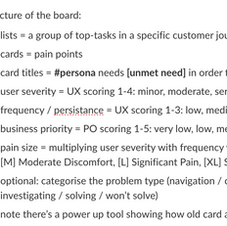UX Surgery: Healing Pain Points and Driving Business Impact
Diagnosed the product’s weak spots and prescribed lasting change
TL;DR
-
Increased conversion by 18% and CSAT by 22% by uncovering and addressing the highest-impact pain points in the product ecosystem
-
Oversaw UX & Product operations with a 20-strong cross-disciplinary team
-
Outcomes:
-
+18% conversion, +22% CSAT, -40% recurring complaints, +30% usage, -12% service queries.
-
Cultural shift to journey-led design, replacing patch fixes with holistic end-to-end improvements.
-
Streamlined UX & Product workflows enabling continuous, feedback-driven optimisation.
-
Project overview
In the digital landscape, empathy is the thread that binds user needs to business objectives and innovation. As Digital Product Development Director at Cambridge University Press, leading UX and Product teams, my mission was to instil a culture of empathy across cross-functional teams and transform abstract user pain into actionable solutions.
This case study details a journey from fragmented feedback to a collaborative process in which user voices shaped real business impact.
Problem statement
We faced a recurring challenge: While we had countless pieces of user feedback and data, we struggled to see the bigger picture of user pain across our platforms. Teams often reacted to isolated complaints, but systemic issues slipped through the cracks. The lack of a holistic view meant opportunities for deep optimisation were missed, and user frustration persisted.
Aged digital platforms, siloed departmental priorities, and the absence of a unified repository for insights compounded the issue.
The challenge was clear:
-
How do we uncover and address the pain points that genuinely matter to users?
-
How can we ensure empathy is not just a buzzword, but a catalyst for meaningful action?
-
How do we bring together Product, UX, Engineering, and Business stakeholders to prioritise and resolve user pain collaboratively?
Process
Empathy mapping: Feeling the pain with users
We started with interactive empathy mapping workshops, stepping into the shoes of our users. By analysing direct quotes, behaviour logs, and attitudinal data, we created journey maps that revealed points of friction, confusion, and emotional lows.
-
Qualitative feedback: We designed surveys and interviews with users to understand not just what they struggled with, but how those struggles affected their goals and emotions.
-
Usability Testing: Quantitative usability tests provided clear metrics on where users stumbled, abandoned flows, or felt dissatisfied.
-
Heuristic Evaluations: Expert reviews paired with user data helped us identify root causes beyond surface complaints.
Building a research repository: From data to insight
Recognising the limitations of passive feedback, we invested in a robust research tool to identify user pain. This digital hub captured pain points, their frequency, their business impact, and supporting data (heatmaps, analytics, recordings). Each pain point was framed as a 'case', complete with visual evidence and user quotes, making it easy for any stakeholder to understand and empathise.
Cross-functional collaboration: Bringing everyone along
-
Collaborative Workshops: We facilitated sessions where UX and Product teams reviewed pain cases together, discussing not only the problems but the emotional weight behind them.
-
Shared Language: To bridge understanding, we replaced abstract sizing with ‘pain language’—terms like “papercuts,” “bruises,” and “headaches” that resonated with both business and technical teams.
-
Open Backlogs: Pain points moved from UX boards to integrated Jira backlogs, blending improvement opportunities with product planning.
Iterative optimisation: Action at every level
Rather than waiting for major redesigns, we broke down epic pain areas into manageable tasks. Each sprint addressed a handful of specific pain points, delivering incremental improvements that built momentum and trust. Regular updates and presentations ensured transparency, showing how each fix moved the needle for users and the business.
Driving ownership and agency
Critical to success was empowering teams to pick up and solve pain points proactively. By visualising progress and value, we inspired engineers and product leads to propose creative solutions. In areas where user pain was particularly acute, we scoped focused optimisation phases, deploying targeted usability tests and gathering feedback on post-fix experiences.
Storytelling and advocacy
Empathy became contagious when user stories were shared. We presented user scenarios at meetings, letting real user voices and journeys spark conversations. Every recommendation was backed by a blend of data and narrative, making the case for change both rational and emotionally compelling.
Outcome
The results were transformative. Not only did key metrics improve, conversion rates rose by 18%, customer satisfaction scores climbed 22%, and recurring complaints in digital commerce dropped by 40%, increased digital product usage by 30% while reducing customer service queries by 12% - but the organisation’s culture shifted. UX was no longer a silo, it was at the core of our strategy.
-
Business Impact: Improvements in digital commerce led to a measurable boost in sales and retention, as friction was systematically removed from user journeys.
-
User Feedback: Post-optimisation surveys and interviews revealed users described the experiences as “effortless.”
-
Team Morale: Cross-team collaboration improved, and stakeholders reported greater satisfaction and agency in driving change together.
Balancing user needs with business objectives
Throughout the process, every recommendation was weighed not only for user benefit but for strategic value. We prioritised solutions that aligned with business goals—whether improving conversion, reducing churn, or enhancing brand loyalty. By connecting empathy-driven problem solving to clear ROI, we demonstrated that designing with empathy is designing for impact.
Conclusion
This case study showcases how effective UX strategy can spark empathy across an organisation, unite diverse teams around real user pain, and convert that empathy into sustained, measurable action. The journey proved that user-centricity is not just a principle, it is a practice, and when championed with conviction and collaboration, it leads to innovation, growth, and lasting change.

Explore additional case studies
-
Growth Strategy: Customer-centric commercial and digital strategy to drive business growth.
-
Service Blueprint: A cross-functional, end-to-end view of customer interactions to identify opportunities and optimise the customer experience
-
Research Repository: Centralising insights to democratise access and amplify research impact across teams.
-
Research Directions: Award-winning, forward-thinking product design driven by deep insight and innovation.









